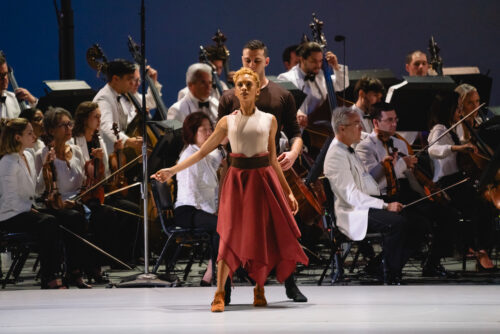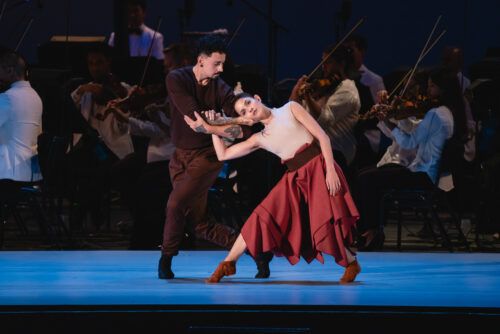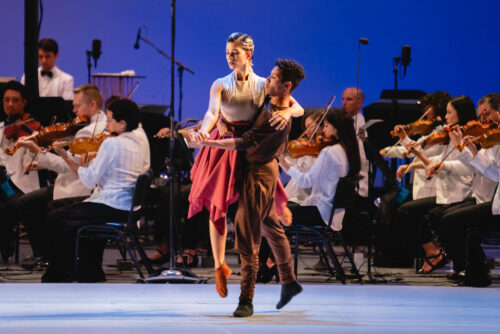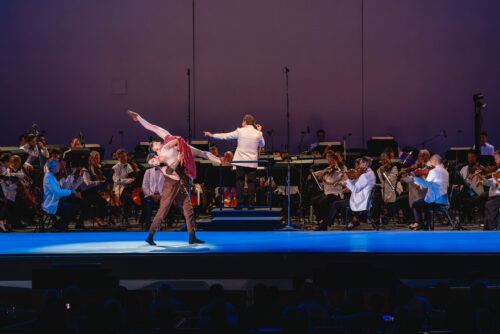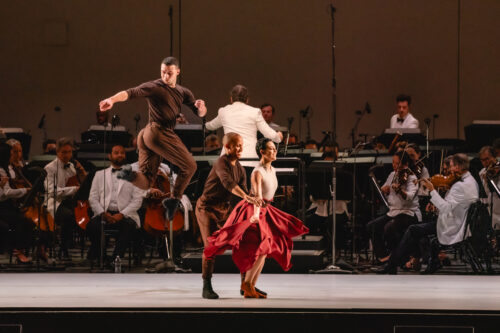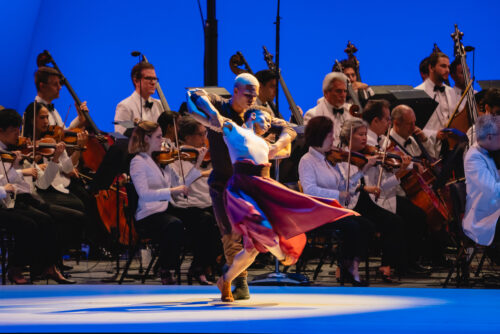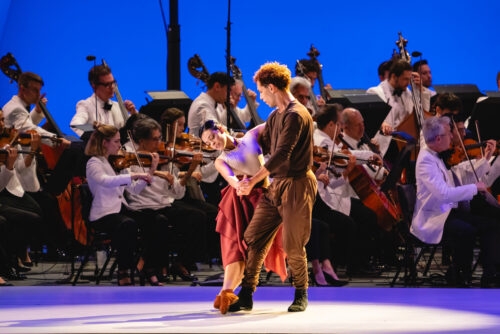PAMPAS PASTORAL
A glimpse of “disappearing Argentine
Gaucho culture” at the Bowl
The Ballet Estancia is one of two musical suites by Spanish composer Alberto Ginastera. Originally intended for a 1942 Latin America tour, the ballet is a love story between an Argentinian city boy and a rancher’s daughter, demarcated by time of day over the course of their two-day affair. There’s dawn, morning, “slow,” twilight, night, and then dawn again. Influenced by his close friend Aaron Copland, Ginastera wrote pastoral longing into the music; it has the feel of a patriotic operetta, an Appalachian Spring with Argentine themes. At Estancia with Dudamel on July 18 at the Hollywood Bowl, a revived and reinterpreted version, danced by the Brazilian troupe Grupo Corpo, was presented by the LA Philharmonic with Gustavo Dudamel conducting and Gustavo Castillo singing the warbling baritone solo.
Gustavo Dudamel with trumpeter Pacho Flores
Baritone Gustavo Castillo and Gustavo Dudamel with Grupo Corpo
Beginning the July 18 program was an 8-minute LA Phil commission by Francisco Cortés–Álvarez, La Serpiente de Colores (The Multicolored Snake), first performed last year at Disney Hall, followed by Arturo Márquez‘s 20-minute Concierto de Otoño (Autumn Concerto), written expressly for the great Venezuelan trumpeter Pacho Flores, who tremendously played four different trumpets over the course of three movements (“Son de luz,” “Balada de floripondios,” and “Conga de flores”).
After intermission, the dancers assembled for Estancia on a narrow strip of marley floor laid in front of the orchestra. Beginning with eight dancers (four men and four women) in brown pants, modest skirts, and farmers’ smocks (costumes by Janaína Castro), the troupe performed staccato and grounded folk-dance influenced movements.
We followed the men of the dance company in an abstraction of peasant dance, as they pumped their arms in unison and then threw the women in the air like rag dolls. In the Hollywood Bowl, which seats 17,500, I strained the dance through a filter of what was legible from hundreds of yards away: women throwing their heads back, a slower partnering dance in “Amanecer” (awakening) in which a woman, lifted by a man, appeared to do languorous moon-landing steps. At one point, six women threw their backs into leaning death-defying arches, only to be kicking and jumping one moment later.
Ultimately the dance followed a familiar pattern of choreography in the zeitgeist now: an abstract piece, filled to the brim with a combination of ballet and contemporary steps done on the beat in cacophonous random order. Combinations of dancers form the landscape of pieces: four couples, then a men’s dance, a women’s dance, a single pas de deux, and a finale piece. Rodrigo Pederneiras‘s choreography is meant to impress but one does not know where to look, there is so much of this contemporary jumble happening at once. If everything is hitting, nothing is. And I wonder how this dance illuminates the music, which is so meticulously crafted around story. I miss the days of narrative in ballet, just as the composer encoded into Estancia the longing for the simple days of a pastoral past. Maybe someday we will return to where we began, but this piece is not that homecoming.
The Dancers: Ágatha Faro, Bianca Victal, Davi Gabriel, Dayanne Amaral, Débora Roots, Edésio Nunes, Giulia Madureira, Isabella Accorsi, Jõnatas Itaparica, Jonathan de Paula, Karen Rangel,Luan Barcelos, Luan Batista, Lucas Saraiva, Malu Figueirõa, Rafael Bittar, Rafaela Fernandes, Tris Martuns, Vitõria Lopes, Walleyson Malaquias, Yasmin Almeida.
photos by Farah Sosa

